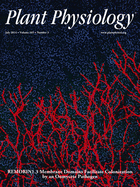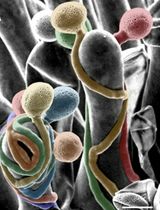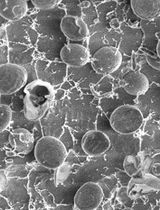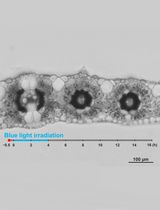- EN - English
- CN - 中文
Transmission Electron Microscopy for Tobacco Chloroplast Ultrastructure
透射电镜观察烟草叶绿体的超微结构
发布: 2015年02月20日第5卷第4期 DOI: 10.21769/BioProtoc.1404 浏览次数: 11379
评审: Tie LiuAnonymous reviewer(s)
Abstract
The chloroplast is the site of photosynthesis that enabled and sustains aerobic life on Earth. Chloroplasts are relatively large organelles with a diameter of ~5 μm and width of ~2.5 μm, and so can be readily analysed by electron microscopy. Each chloroplast is enclosed by two envelope membranes, which encompass an aqueous matrix, the stroma and the thylakoids. Components of stroma include starch granules and plastoglobuli, which can be observed by electron microscopy. And the thylakoids consist of stromal thylakoid, granal thylakoid and as well as granum (a stack of thylakoids). These structure components are quite sensitive to developmental changes and environmental variations, such as drought, salinity, cold, high temperature and others. Transmission electron microscopy (TEM) is a powerful technique for monitoring the effects of various changing parameters or treatments on the development and differentiation of these important organelles. Here we describe a reliable method for the analysis of plastid ultrastructure in tobacco plant by TEM.
Keywords: Chloroplast (叶绿体)Materials and Reagents
- Tobacco (Nicotiana tabacum) plants (about 6-week grew on MS agar plates, 3-week grew in 1/4 Hoagland solution, and 2~3 weeks grew on soil)
- Glutaraldehyde (Wako Pure Chemical Industries, catalog number: 071-01931 )
- Osmium tetroxide (Nisshin EM Corporation, catalog number: 300 )
- Ethanol (Wako Pure Chemical Industries, catalog number: 057-00456 )
- Propylene oxide (Wako Pure Chemical Industries, catalog number: 165-05026 )
- Quetol 812 set (Nisshin EM Corporation, catalog number: 340 )
- Uranyl acetate (Wako Pure Chemical Industries, catalog number: 6159-44-0 )
- 3% (w/v) lead citrate (Wako Pure Chemical Industries, catalog number: 121-01722 )
- Dodecenyl succinic anhydride (DDSA)
- Methyl nadic anhydride (MNA)
- DMP
- 0.1 M phosphate buffered saline (see Recipes)
- 1% osmium tetroxide (see Recipes)
- Quetol-821 resin (see Recipes)
- Hoagland solution (see Recipes)
Equipment
- Razor blade
- Lens tissue
- Scissors
- Tweezers
- Needle and thread
- Glass tube
- Vacuum equipment
- Balance
- Petri dish
- Oven at 60 °C
- Plastic flat embedding mold (catalog number: 70900 )
- Beaker
- Ultramicrotome (RMC, model: MT-7000 )
- Copper grid
- Transmission electron microscope (JEOL, model: JEM-100CX II )
Procedure
文章信息
版权信息
© 2015 The Authors; exclusive licensee Bio-protocol LLC.
如何引用
Readers should cite both the Bio-protocol article and the original research article where this protocol was used:
- Yin, L., Wang, S., Shimomura, N. and Tanaka, K. (2015). Transmission Electron Microscopy for Tobacco Chloroplast Ultrastructure. Bio-protocol 5(4): e1404. DOI: 10.21769/BioProtoc.1404.
- Wang, S., Uddin, M. I., Tanaka, K., Yin, L., Shi, Z., Qi, Y., Mano, J., Matsui, K., Shimomura, N., Sakaki, T., Deng, X. and Zhang, S. (2014). Maintenance of chloroplast structure and function by overexpression of the rice MONOGALACTOSYLDIACYLGLYCEROL SYNTHASE gene leads to enhanced salt tolerance in tobacco. Plant Physiol 165(3): 1144-1155.
分类
植物科学 > 植物生理学 > 光合作用
植物科学 > 植物细胞生物学 > 细胞结构
细胞生物学 > 细胞成像 > 电子显微镜
您对这篇实验方法有问题吗?
在此处发布您的问题,我们将邀请本文作者来回答。同时,我们会将您的问题发布到Bio-protocol Exchange,以便寻求社区成员的帮助。
提问指南
+ 问题描述
写下详细的问题描述,包括所有有助于他人回答您问题的信息(例如实验过程、条件和相关图像等)。
Share
Bluesky
X
Copy link












